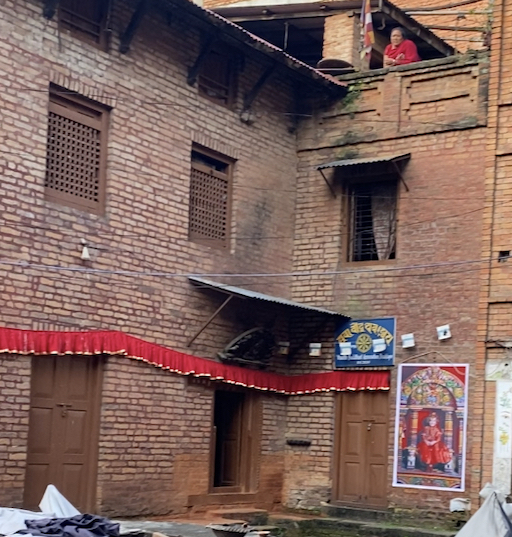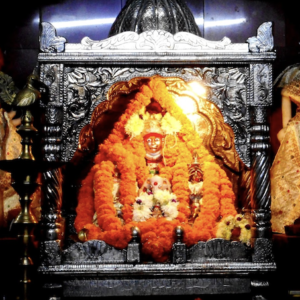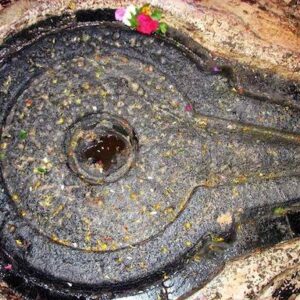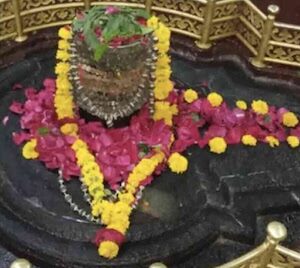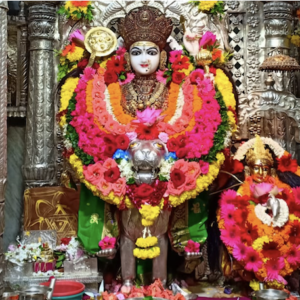Kumari is a Nepali word meaning ‘virgin goddess.’ The Royal Kumari, as the spirit of the Taleju goddess believed to be embodied in a long succession of Nepali girls, has been worshiped for centuries. Traditionally speaking, Taleju is the state goddess, the chief protectress of the royal lineage, and virgin mother of the world. Interestingly, the Royal Kumari is always chosen from the Newar Shakya clan. Though the Kumari is Buddhist by birth, the Taleju is a very important Hindu Goddess. This unique tradition is a perfect example of the intertwining and peaceful coexistence of religions Nepal has long been known for.
Young girls must have the 32 perfections of the goddess in order to be a Royal Kumari. The list of requirements is elaborate: she must have perfect health without any history of serious illness, unblemished skin, black hair, gorgeous expressive eyes, a sonorous voice, long slender arms, delicate and soft hands and feet, straight hair curled towards the right side, no bad body smells, and must not have shed any blood. The most important requirement is that the girl has never menstruated. When a Kumari has her first menstruation, she loses her divine power and is returned back to life as an ordinary girl. (Menstruation is seen as a mark of impurity in traditional Nepali society. Hindu girls must stay inside a closed room for the first two weeks after their first menstruation, avoiding contact with males and sunlight. At the end of the two weeks, the girls have to perform specific rituals with priests before they can return to ordinary life. This is a tradition that has been continued for centuries.) Her family’s reputation for piety is taken into consideration by the selection committee, which also looks for calmness and fearlessness in the girl. To ensure the girl’s compatibility with the King of Nepal, her horoscope is compared and must match with his, as the Kumari has an important role in relation to the King, including the traditional power to confirm the King’s rule.
The nominated girl then undergoes an extraordinary test on the night of Kalratri (the eighth night of Dashain festival). She must pass by one hundred and eight buffaloes and goats that have been sacrificed to the Goddess Durga, without any fear. If she maintains a perfectly calm demeanor through the circuit of carnage, she is taken into the Taleju temple by a high priest and installed as the new incarnation of the goddess.
There are actually eleven living goddesses in Nepal known as Kumari. They are chosen for various towns because Kumaris are believed to protect the towns from evil powers. The three most important Kumaris are each associated with one of the three main towns of the Kathmandu Valley: Patan, Bhaktapur and Kathmandu. The Royal Kumari of Kathmandu is by far the most influential and revered.
The Royal Kumari lives in a magnificent, intricately carved three-floored wooden and tile temple where she performs her daily rituals. This temple, known as the Kumari Chhen or Kumari Ghar (Kumari House), is located on the southern end of Basantapur Durbar Square. The Kumari House is a favorite tourist spot; every day one can see enthusiastic foreigners and devotees flocking into the courtyard of the Kumari House. Non-Hindus are allowed to enter the premises but not all can visit the Kumari.
Throughout her span as the goddess, the Kumari has to live in isolation from her family. Even when her actual family members visit her, she is treated with respect and a kind of distance because she is no ordinary girl, she is the goddess. A ‘chitaidar’ (woman caretaker of the Kumari) is assigned to look after the everyday needs and general upbringing of the goddess. The entire family of a chitaidar lives with the Kumari. The eldest daughter-in-law of each chitaidar replaces her mother-in-law immediately when the chitaidar dies or is unable to perform the job properly. (The current caretaker is the sixth chitaidar of Kumari Chhen.)
The goddess spends several hours each day upon her throne, receiving up to a dozen visitors, who may range from peasants to government officials. The movements of the goddess during offerings of the devotees are regarded as omens. If she cries or laughs loudly, the worshipper is expected to become seriously ill or even die. If she weeps and rubs her eyes, the worshipper will die immediately. If she trembles, the person will go to jail; if she claps her hands they will have a cause to fear the King; if she picks at the food offered, the visitor will soon lose money. If none of the ominous signs appear, the worshipper’s wish will be fulfilled.
There are only fifteen days a year when the Royal Kumari comes out from her temple for festivals. One of these is Kumari Jatra, part of the celebration of Indra Jatra (festival of Indra, the God of Rain), which is the largest public festival in Kathmandu. On this occasion, devotees gather to witness the procession of the Kumari in her enormous chariot. The chariot, set on massive wheels, covered with gold plated copper sheeting, and culminating in a double roofed pagoda, travels the main thoroughfares of Kathmandu on a scheduled route for three days. During this festival the Kumari also blesses the King, in keeping with the tradition in which Prithi Narayan Shah (the Shah king who unified many small kingdoms and formed Nepal, invading and conquering Kathmandu in 1768) received a blessing from the living goddess. The Goddess Kumari is regarded as so powerful that this annual blessing of the King, the royal family, and government officials is considered essential to the successful reign of all sovereigns.
The Kumari’s feet must never touch the ground; to do so is considered impure. The few times she appears outside the palace for non-festival occasions, the Kumari is carried in a covered palanquin. During her tenure in the god-house, a government trust fund bears her entire expenses, including that of her caretakers.
Traditional Dress and Ornaments
The Kumari is considered the perfect beauty of the Himalayan kingdom. Especially in the Newari community, a girl’s beauty is often compared to that of the Kumari. The clothing of the Kumari has always fascinated westerners and even Nepalis. For festivals and other formal occasions, the Kumari is always dressed in red, because red is considered the color of gods and power among Hindus in Nepal. The Kumari wears a bright red jama (cloak) down to her feet, a red bhoto (shirt), and a red pagari (turban). She wears ornaments not only around her neck but also on her hands and feet; her hair is gathered in a topknot and decorated with sweet smelling flowers; and she has a third eye (called ‘tri-netra’) painted on her forehead. The third eye is a metaphorical eye, which is believed to destroy all the evil in the world.
The Kumari wears garlands of diamonds and gold coins, and two necklaces of special symbolic significance. One is a golden chain made in the shape of the serpent god called ‘Basuki Naga’ on her neck, hanging down to her belly. This ornament has multiple meanings. Firstly, it is considered a symbol of the guardian of the national treasury because Basuki Naga was reincarnated as lord Kuber (guardian god of wealth). The Goddess Kumari is also worshiped as the goddess of wealth, Laxmi, during the Tihar festival. Secondly, the serpent is often used as a symbol of anger. Thirdly, the serpent god Naga is also closely related to the monsoon, the most important of all seasons for farmers, as during this time snakes frequently bite farmers. Therefore, people also worship Naga during Kumari Puja for protection: of their wealth, and from anger and snakebite.
Another ornament the living goddess wears is a four inch long golden ta-yo, which, has a cylindrical body with a number of edges and a conical shape at both ends. This is sheltered under the umbrella of an eight-headed miniature golden Naga, which symbolizes the eight mother goddesses. The Kumari wears it around her neck (it extends down to her chest) to indicate her authority with the eight mother goddesses.
It is believed that these ornaments were prepared near the end of the rule of the Malla kings, when the Kumari tradition began. The ceremonial clothes and ornaments are passed from one Kumari to the next, through the ages. Only the Royal Palace has the authority to change the original pieces if torn or destroyed. On non-festival days the Kumari wears ordinary clothes, which are the offerings of people who come to worship her.
The Kumari’s red tika, which is placed on her forehead (above the third eye) artistically during festivals, is called bhrigu. It represents the cosmic energy of the earth. This brightest and most glowing tika is a sign of wealth, prosperity and a bright future for the nation. The special tika is prepared by mixing vermilion powder, rock crystal powder, a kind of sweet scented natural powder called ‘kumkum’ and sesame seed oil.
The Kumari and the King
There are several legends alluding to the Kumari’s power over the King. It is said that in the old days – around the 15th century – the kings of Nepal would sit with the goddess Taleju face to face and play dice for hours. During the 17th century, Jaiprakash Malla (the last Malla ruler of Kathmandu) used to play tripasa, the ancient dice game, with the goddess Taleju. While playing the game, the king curiously cast a wistful glance at the goddess, who was a great beauty with the flame of youth. The king stopped concentrating on the game as he was seized by a very strong amorous desire. No sooner had he moved a step to embrace her, when the goddess Taleju disappeared, to his great disappointment. Soon the king heard the voice of Taleju warning “from now on you will never see me in my original state again because you have committed a big crime in trying to seduce me. You will soon be punished with death. However, if you want to atone for your crime, have a temple built for me wherein I will reside in the form of a virgin girl from a low caste family.”
Another version of the legend tells us that the Kumari Ghar and the tradition of Kumari Jatra were established by Jaiprakash Malla when the goddess Taleju came to him in a dream and said, “you will loose the state shortly and another dynasty will come to rule here. If you want to prolong your rule for a few years, build a house for me and start a tradition of jatra.” The King constructed a Kumari Ghar next to the then Royal Palace (the present Basantapur palace) and established the virgin goddess in it. He also obeyed Taleju’s advice in starting the procession of Kumari Jatra.
Thereafter, Kumari worship by the King, his officials and subjects became widespread within the three Valley kingdoms of Patan, Bhaktapur and Kathmandu. The Kumari legends and the traditions that have grown up around them remain a strong and unifying aspect of Nepali culture today.
